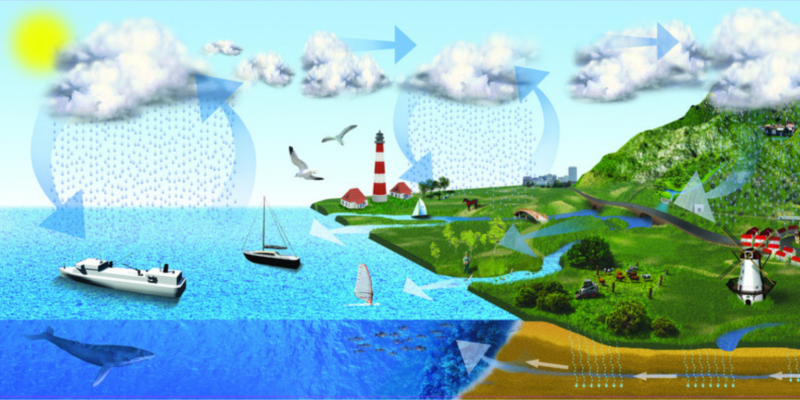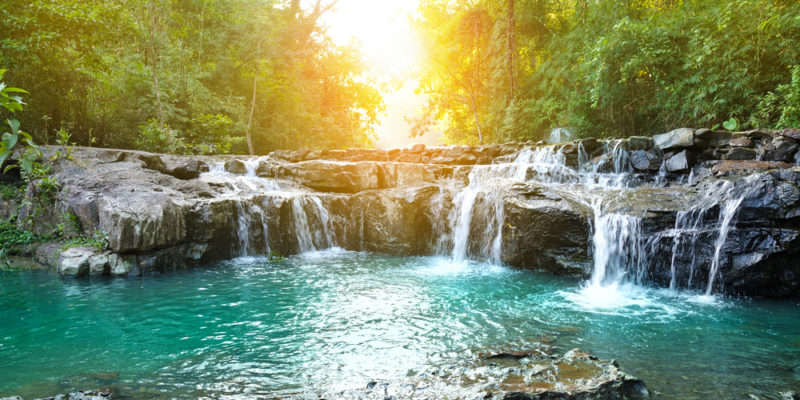We explain the water cycle, and the various processes that compose it. In addition, we discuss its stages and importance.

What is the water cycle?
The water cycle, or hydrologic cycle, is the process by which water circulates through the different components of the hydrosphere. The hydrosphere is composed of oceans, rivers, seas, clouds, rain, glaciers, and any other medium in which water accumulates in its different states.
During the water cycle, water constantly changes its state of aggregation, meaning it can transition from liquid to gas, from solid to gas, from gas to liquid, from gas to solid, from solid to liquid, and from liquid to solid. For example:
- Water in a lake evaporates, condenses to form clouds, and then precipitates back into the lake.
- Water vapor in the air condenses to form clouds. If temperature drops, it solidifies, precipitating in the form of hail and accumulating as solid ice.
- Groundwater is absorbed by plants and then released into the atmosphere through transpiration. In its gas phase, it condenses in the air and precipitates, infiltrating back into the subterranean layers of the soil.
- See also: Greenhouse effect
Stages of the water cycle
The water cycle consists of various processes, which are interrelated both to each other and to living beings:
- Formation of gas-phase water
- Evaporation. Evaporation is the process by which water from oceans, rivers, lakes, and seas changes into water vapor due to a rise in temperature.
- Transpiration. Water vapor forms due to transpiration in plants and animal sweat.
- Sublimation. It is the transition of solid water that forms glaciers into gas-phase water.
- Condensation. It is the process that occurs when water vapor in the atmosphere condenses to form small droplets due to a drop in temperature. This is how clouds form.
- Precipitation. This process occurs when the water droplets that form clouds cool and merge, causing larger droplets to form, which then fall to the Earth's surface.
- Infiltration. It is the process that occurs when water falling on the Earth's surface enters the soil. Precipitation causes water to pass through the surface's pores, becoming groundwater. Infiltrated water may return to the atmosphere by evaporation or plant transpiration. It may also rise entering aquifers.
Infiltration is affected by the permeability of the soil; when the soil is not porous or contains a lot of moisture, infiltration is reduced. - Runoff. Runoff is the process by which water flows over the ground surface when it overflows the natural reservoir in which it is found. Water flowing overland is one of the main means by which sediments and nutrients necessary for plant and animal life are transported, hence it is of vital importance that it is not polluted. Runoff is also one of the causes of soil erosion, especially when they are not permeable.
- Melting. It occurs when solid water is transformed into liquid water due to a rise in temperature. This is the case with the melting of snow, which turns into water.
- Solidification. It is the process by which liquid water transforms into solid water (ice). It occurs within clouds: when there is a significant drop in temperature, the water condensed within clouds turns into ice and precipitates in the form of snow or hail.
Importance of the water cycle
The water cycle ensures that water is reused by living organisms over and over again.
Because water transforms from one state of aggregation to another during the water cycle, this resource can continuously transform from other states of aggregation to its liquid state (the state of water most used by living beings), ensuring that it is not depleted.
Nevertheless, it is key to avoid water pollution in any of its aggregate states, as contaminated water often cannot be purified nor reused.
Thanks to this cycle, water can also transport chemical compounds and nutrients needed by animals, humans, and plants.
Springs and groundwater flow

A spring is the outflow of groundwater to the surface or to near-surface areas that can be used by animals and humans. Since this water is filtered through several soil layers, springs can be sources of drinking water.
Springs form when rainwater infiltrates into an area that is higher than where the spring water emerges. Therefore, it is vital to avoid surface water pollution in order to prevent polluted water from infiltrating and contaminating the spring.
Underground water currents may flow into rivers, lakes, or seas without emerging to the surface.
Seas and oceans
Seas are bodies of water located adjacent to oceans, though they can sometimes be part of them. Seas are usually partially surrounded by land.
Seas and oceans are the largest water reservoir on the planet, accounting for approximately 97% of the world's water supply. However, it is worth pointing out that this water is nor drinkable, as it contains sodium chloride (NaCl), that is, it is salt water.
In addition to sodium and chlorine, other elements such as magnesium and bromine have been found in ocean water, which are currently exploited for commercial use.
Explore next:
References
- “¿Qué son los manantiales de agua?” En: iAgua Consultado: 19 de octubre de 2022.
- “Hidrósfera” En: Wikipedia. Consultado: 19 de octubre de 2022.
- “Mar y océano” En: EcoExploratorio. Consultado: 19 de octubre de 2022.
- “Importancia del Ciclo del Agua” En: Importancia.Consultado: 19 de octubre de 2022.
Was this information useful to you?
Yes NoThank you for visiting us :)